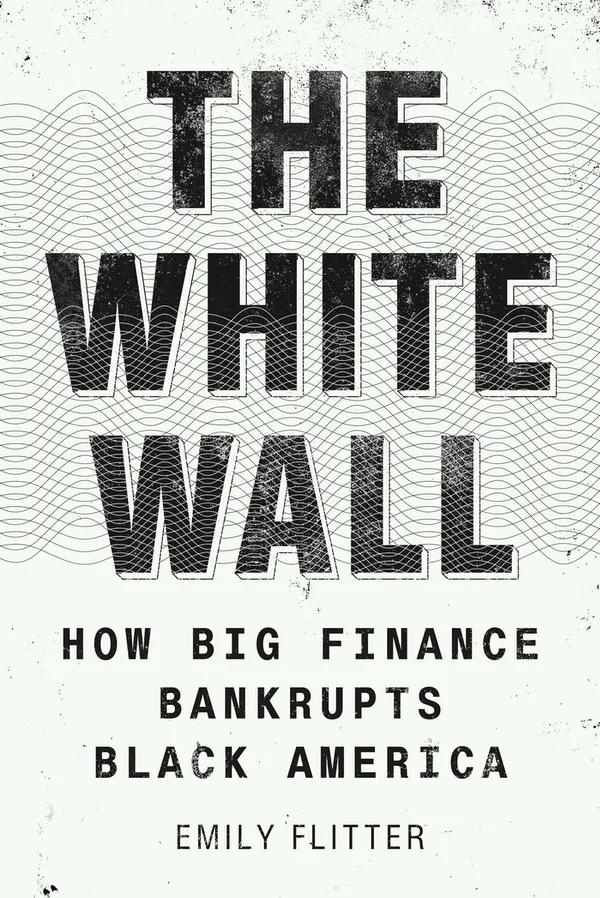The White Wall: How Big Finance Bankrupts Black America Review

Cover of The White Wall: How Big Finance Bankrupts Black America by journalist Emily Flitter
Emily Flitter's book, The White Wall: How Big Finance Bankrupts Black America takes a look at the ways in which banks and insurance companies short change Black employees, customers, and communities. Flitter, a finance reporter who currently works at the New York Times relies heavily on anecdotes in this book. As a result, it puts the focus on problems at institutions, but not necessarily on institutional problems. I don't think Flitter does enough to connect these anecdotes to a larger, data-driven picture.
Chapters 1 and 2 of the book focus on racism in customer service operations. Flitter leads with stories of bank customers who were viewed as suspicious for reasons that amounted to little more than they were Black. These were cases in which customers had documentation of their identities and easily-confirmed stories.
Flitter also looks at the stories of Black employees of financial institutions in chapters 3–6. Again, with anecdotes, Flitter tells us:
- how one Black former employee of JP Morgan's Chase arm was undermined by his managers as he attempted to join the ranks of Private Client managers;
- how door-knocking as a sales tactic disadvantages Black investment advisors at Edward Jones; and
- how poorly high-ranking executives, including former Credit Suisse head Tidjane Thiam, were treated despite their leadership positions.
Here too, these stories aren't connected to enough data to illustrate widespread patterns. Don't misunderstand me: these problems are real, pervasive, systemic, and systematic1 in the case of algorithmic processes. But by not connecting these anecdotes to data, it becomes easy to dismiss them as issues with specific companies, office locations, and managers.
That may just be because there isn't much data to connect. Do banks review their Please Use Caution emails for mentions of race? How do investment advisors assign territories for canvassing? Do they review applicants, hirings, firings, departures, and promotions for racial disparities? Do mortgage lenders examine which census tracts or ZIP codes they make loans in and compare that with the racial, income, and wealth compositions of those neighborhoods? Flitter does mention that some of this data just isn't available. I'm guessing that's so these institutions don't open themselves to a lawsuit.
Part 4 of the book is a little bit stronger. In Chapter 11, Flitter looks at the reparations movement, and a legal effort to get banks to pay reparations for their part in the slave trade. As Flitter explains, enslaved Africans and African-Americans were used as collateral for bank loans. If borrowers defaulted, those banks became slaveholders. Banks, in other words, perpetuated actual harm. The assets and liabilities of the entities that made those loans and owned those slaves still exist. Bank of Charleston, one of the banks Flitter says made loans using slaves as collateral, eventually became Wachovia. Wachovia was later acquired by Wells Fargo during the 2008 financial crisis. So what does Wells Fargo owe to the descendants of those slaves, or to Black America more broadly?2
In Chapter 12, Flitter calls out bank efforts to invest in Black communities
by making loans to Black customers and creating borrower education programs rather than by giving people money. As Flitter tells us, mortgage lending earns the bank money in the form of fees and interest payments. I'll add that mortgage debt only translates to wealth when the property is worth more than the loan balance. Asset appreciation is not guaranteed for Black homeowners. Flitter correctly concludes that these steps don't fall short of repairing the harms of slave ownership, redlinining, and discrimination.
The White Wall is an easy read. It's an adequate introduction to the topic if you aren't well-versed in it. I do, however, think there are more informative works about the interplay between race and wealth. Flitter, in fact, mentions those works in this book:
- Know Your Price by Andre M. Perry of The Brookings Institution;
- Race for Profit: How Banks and the Real Estate Industry Undermined Black Homeownership by Keeanga-Yamahtta Taylor; and
- The Color of Law: A Forgotten History of How Our Government Segregated America by Richard Rothstein.
I also recommend two books published in the mid-2000s that helped me understand impact of race on wealth.
- The Hidden Cost of Being African American by Thomas M. Shapiro, whom Flitter briefly mentions in the introduction; and
- Being Black, Living in the Red by Dalton Conley
-
Read 'Systematic' or 'Systemic'? if you need clarity about the difference between these two words. ↩
-
The answer, legally, is “nothing.” The lawsuit at the center of this effort was dismissed by the court. ↩